By Roger A. Herbst

From the jungles of Nicaragua to the beaches of Normandy to the rice paddies of Viet Nam, the Thompson submachine gun provided outstanding service in conflicts and wars throughout much of the 20th century.
Some of these Thompsons were the guns made by Colt’s Patent Firearms Company in 1921-22. Most were guns made by Savage or Auto-Ordnance during World War II, but a few were cobbled together by nations in need of reliable, effective small arms. Such was the case in China and on the small island of Cyprus in the Mediterranean. Cyprus was the birthplace of the Turkish Thompsons.
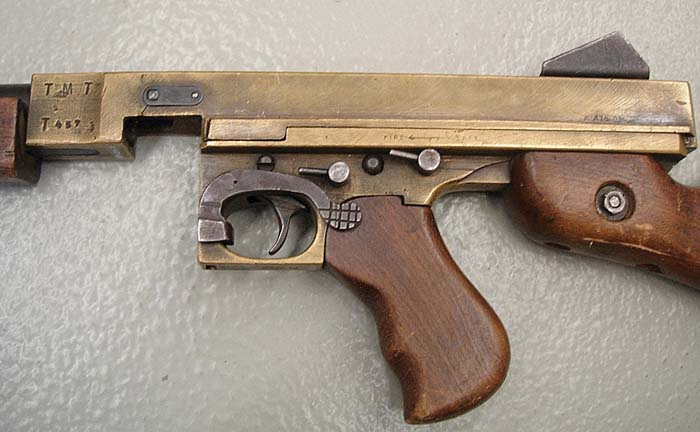
The October 1976 issue of Gun World magazine contains a reference to these Turkish Thompsons in their Tech Tips section. Under the heading of Combat Find, there is an extensive description of Turkish M1A1 Thompsons that were encountered by Canadian UN peacekeeping forces on Cyprus. The author of that article, Captain J.M.G. Gagné, believed those Thompsons were made on the island probably in the 1960s-70s for use by the Turkish Cypriot resistance.
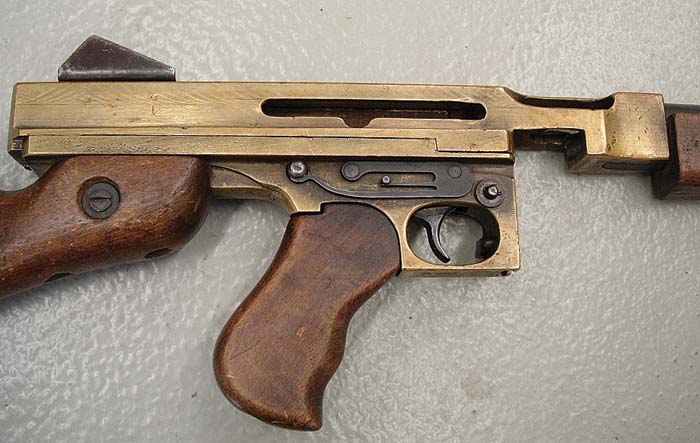
During the conflict, and especially after the Turkish invasion in 1974, the Canadian Airborne forces on Cyprus did observe Turkish Army units armed with U.S.-made Garand rifles, Browning machine guns and Thompson submachine guns. The presence of these arms was likely due to the fact that Turkey was the recipient of a lot of U.S. surplus arms post World War II. According to Captain Gagné, “Turkey could have easily supplied the Turkish Cypriots with American weapons, but it is assumed that they could not politically take this risk. Doing so would have created a furor in the U.S. government. By providing only a few essential parts, they could help them manufacture the weapons and thus save face.”
A sentence in the February 1966 issue of Shooting Times references the Turkish Army’s use of Thompsons: “A goodly number are in the hands of the Chinese Communist and Turkish Armies today.” This quote likely refers to the surplus weapons mentioned above, but this story is about the Turkish-made Thompsons.
Action on Cyprus
UN Peacekeeping forces were originally sent to Cyprus in 1964. Among them was the Canadian Airborne Royal 22e Regiment (see information about this unit and their museum, La Citadelle, in the January 2007 issue of SAR). Captain Gagné, now a retired Major, was a member of that Regiment, and the following is his description of his first encounter with the Turkish Thompsons.
“Trouble started in Cyprus in December 1963 and gradually degenerated towards civil war. The UN deployed a peacekeeping force in March 1964. Canadian units were there from the start and rotated every six months for over 30 years. I served there the first time in 1968-69 as a platoon commander in the Turkish sector in the Northern part of the island, and it is then that I first saw these guns. I clearly recall the brass receiver version because it definitely attracted attention, but I cannot recall for sure if there was the steel version at that time.”
All of the Turkish Thompsons are the M1A1 model firing standard .45 ACP ammunition. The barrels, magazines, and some small parts were U.S.-made. All other components were made on the island with varying levels of quality. It is not known how many Turkish Thompsons were made, but Major Gagné guesses somewhere between a few thousand and 10,000.
Some of the Canadian troops liked the Thompsons so much that they used confiscated weapons when they were on patrol. Even though the Canadian government only issued ten rounds to UN soldiers, one enterprising soldier, Master Corporal Mackenzie, did some trading to acquire ten fully loaded 30-round magazines. Not surprisingly, he liked 300 rounds better than 10 when on patrol.
Identification of Turkish Thompsons
The weapons first observed in 1968 had brass receivers and trigger frames. The smooth barrels (no cooling fins) had the compensator installed, which was not used on any M1 or M1A1 guns made in the U.S. The compensator was welded to the barrel rather than screwed on, probably because they were using M1 barrels which were not threaded at the muzzle. Some of the compensators were U.S.-made and some were Turkish-made. The proper threads were cut into the front of the receiver for barrel installation. The buttstock, rear grip and foregrip were all made of olive wood. Turkish Thompsons that Major Gagné observed during a later deployment had steel receivers and the standard M1 uncompensated barrels with the front ring sight.
It is not surprising that brass was used for some of the receivers, since it has been a common fabricating metal in the eastern Mediterranean for centuries. Its mass does mean that a brass Thompson weighs noticeably more than a steel one. A person who has shot the brass Thompson indicated that the extra weight essentially eliminates felt recoil and that barrel climb was minimal. It is not known whether the two receiver materials were used concurrently by different fabricators or the steel replaced the brass version.
All Turkish Thompson receivers are stamped TMT on the left nose of the receiver with the serial number below the TMT. TMT stands for TÜRK MUKAVEMET TESKILATI, the major Turkish resistance organization on Cyprus. The earlier serial numbers have a T prefix, while the later ones have only the number. These are the only markings on the receiver. It appears that the T prefix was dropped for four-digit serial numbers, but there are currently too few identified examples to confirm this.
The trigger frames contain the markings for the selector and safety the same as on U.S.-made Thompsons. However, the brass trigger frame markings are in English while the markings on the steel trigger frames are Turkish. The English markings apparently copied a Savage-made M1 as the FULL AUTO is on two lines instead of one line like the Auto-Ordnance-made M1s. The lettering on the brass frame is a much finer font than on the steel version and is not deeply struck, and the arrow lines appear to have been scribed rather than stamped.
A number of both versions were brought back to Canada in 1974 by Canadian Airborne commandos. Some went to museums and others were retained by soldiers, which was allowed by Canadian law at that time as long as the weapons were registered.
There is no documentation indicating how many of the Turkish Thompsons entered Canada, but known examples are rare. So far, four have been specifically identified. They are serial numbers T272, T457, T525 and 1150. The first two, T272 and T457, are the brass receiver version. The latter two are the steel receiver version. This limited sample does not provide enough information to determine whether there were unique serial number ranges for the brass and steel versions.
The RCMP (Royal Canadian Mounted Police) took ownership of T272 and 1150 in 1978. T272 is now a specimen in the RCMP firearms reference library, but the location of 1150 is not currently known. TMT T272 was valued at 10,000 U.S. dollars in 1976, so today’s value would be considerably higher, even in the restricted Canadian market.
Some examples of the Turkish Thompsons were imported into the U.K. in 1970 by a dealer. These included a few with the brass receiver and others with the steel receiver. One of those steel versions, serial number 2630, was recently identified, but unfortunately was also just deactivated according to current U.K. specifications.
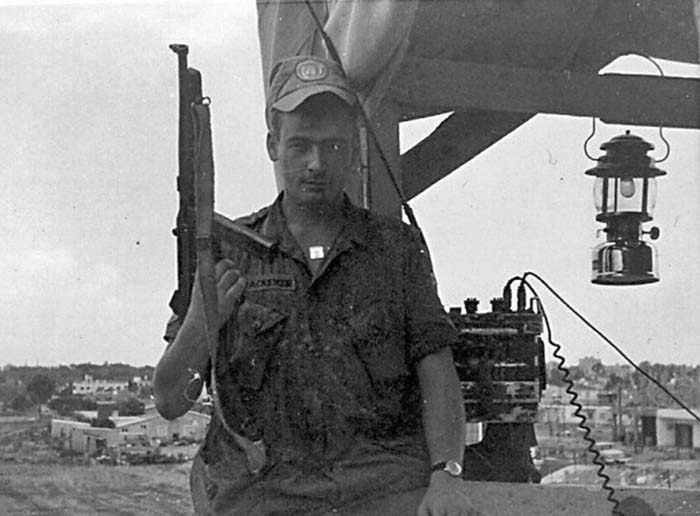
Turkish Thompson Detailed Analysis
Serial number T457 is in the Canadian Airborne Forces Museum in Petawawa, Ontario. It is an intact example of the brass Turkish Thompson. A compensator is welded to the front of the barrel and all of the wood is olive, both features that Major Gagné had observed. However, the compensator on T457 is Turkish-made rather than U.S.-made, a departure from what Major Gagné had originally seen. All of the trigger frame internals appear to be Turkish-made based on their quality and the absence of the manufacturer marks seen on U.S.-made components.
Other interesting features of T457 beyond its brass receiver and trigger frame are: (1) a hand-made 1921/28 style magazine catch with crude hand “checkering” and held in place on the right side of the receiver with a steel washer and cotter pin; (2) a cross-bolt reinforced buttstock using a standard bolt, nut and washers; (3) a unique front swivel made from a brass sling buckle; (4) the front support of the foregrip mount is welded to the barrel; and, (5) the rear angled profile of the trigger frame does not match the receiver angled profile as it does on a U.S.-made gun.
Serial number T525 is in the hands of a private collector in Canada, but has been significantly modified from its original configuration. The receiver, trigger frame and rear sight are Turkish, but the barrel, all of the wood and internals have been replaced with aftermarket or U.S. surplus parts that are not original to the weapon. The weapon was modified or “deactivated” according to current Canadian law, which involved welding the selector to semiautomatic only.
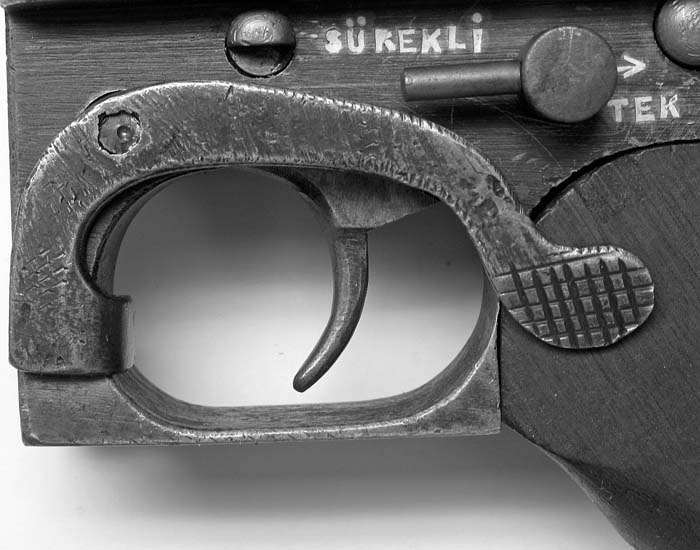
The TMT and T prefix on T457 and T525 use a large handmade font, but the serial numbers are the same size font that is used on the steel trigger frame markings and are struck deeper into the metal than the letters. Interesting features of T525 are: (1) the protected rear sight has been installed slightly canted to the side; (2) the hole drilled at the rear of the receiver is off-center; and, (3) the corner profile at the back of the receiver does not align with the trigger frame corner profile, a characteristic it shares with its brass brethren.
A Steel Turkish Trigger Frame and Internals
Parts of Turkish Thompsons occasionally show up on the market in the U.S. A thread on Frank Iannamico’s “Thompson Message Board” in October of 2003 discussed the origins of Turkish-made Thompson trigger frames, apparently started as a result of one being sold online. One individual indicated that he owned a Turkish trigger frame and had seen several for sale in recent years. Unfortunately, he could not be contacted for further information.
A steel trigger frame from a Turkish Thompson came up for sale in May of 2006 and is described below. It has the Turkish markings that are standard on the steel version of the Turkish trigger frames. The seller indicated that this frame came out of Ohio as part of a trade of a large number of parts, but he did not know anything more about its history.
The finish on this trigger frame is not spectacular, but appears to have been originally blued. The trigger frame did not include the buttstock assembly, rear grip screw, magazine trip or rocker. The U.S.-made rear grip included was not original to the frame because it is walnut instead of olive wood and could not be attached without interference with the magazine catch. Both the rocker and magazine trip are present on the intact examples studied (T457 and 2630), so the missing parts were apparently pilfered or lost from this trigger frame at some point over the years.
All of the trigger frame markings are original, strong and deep, including special Turkish characters. Three of the four markings translate easily, even with the special letters. On one side of the selector switch, SÜREKLI translates to continuous, ceaseless, or the author’s personal favorite, unrelenting. On the other side, TEK translates to single or one. The one marking on the safety lever, EMNIYET, translates to safety. However, ATES did not appear in any Turkish dictionary. It is obvious what it should mean, but direct translation was not readily available.
Several months after the trigger frame was acquired, an article appeared in the Wall Street Journal that included a reference to the Farsi (Persian) command to fire a weapon, Atesh. Previous research in Turkish had indicated that the special character S in ATES (with punch under S) is a special consonant that is pronounced “sh”, which means ATES is pronounced “Atesh”. Translation mystery solved. ATES means Fire. Apparently Turkish has borrowed a number of words from other regional languages, including Farsi, especially in the period that this trigger frame was probably made.
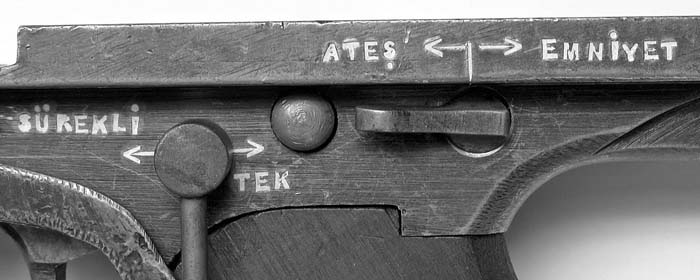
This trigger frame is an interesting mix of U.S.-made and Turkish-made parts, which ties in with comments by Major Gagné about their source. The U.S. parts are the pivot plate (Apex), pin style selector (Savage), paddle style safety (Savage) and sear lever (Stevens). The remaining internal parts are all Turkish-made, including the trigger, disconnector, sear and springs.
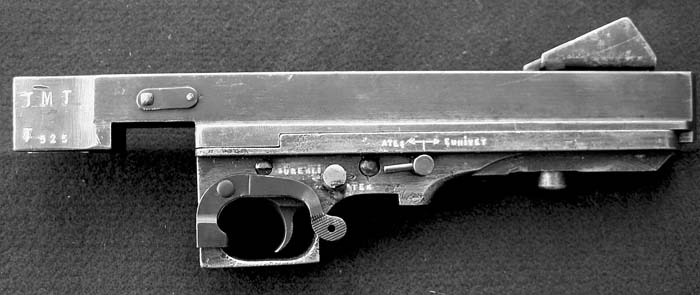
The number 13 is stamped on the larger parts (frame, trigger and magazine catch). This numbering may have been an assembly number or a maker number since the various parts were suspected to have been made by many different sources in different locations on the island.
The trigger frame on the privately-owned example in Canada includes the number 14 stamped on the bottom of the trigger frame behind the rear grip rather than inside the frame. However, since the internals of this weapon were all replacements, it is not known if the original Turkish parts also had the 14 present. The number 3 is stamped on the inside of the T457 trigger frame but not on any of the internal components and 39 is stamped on the inside of the receiver on 2630 but not on its trigger frame.
The dimensions of the trigger frame are similar to a U.S.-made frame, but a number of differences indicate that the tolerances used in U.S. manufacture were not strictly followed by the Turkish makers, or perhaps the equipment being used was not capable of maintaining those tolerances. The Turkish trigger frame does not readily fit a U.S.-made receiver.
The metal of the frame behind the trigger is much thinner than a U.S.-made frame. The side-to-side thickness of the frame in the grip area is 0.030 inch less on the Turkish example, which means a U.S.-made rear grip will not fit properly without significant sanding, especially under the magazine catch. The slot cut for the magazine back rib has squared corners rather than the rounded corners found on U.S.-made frames.
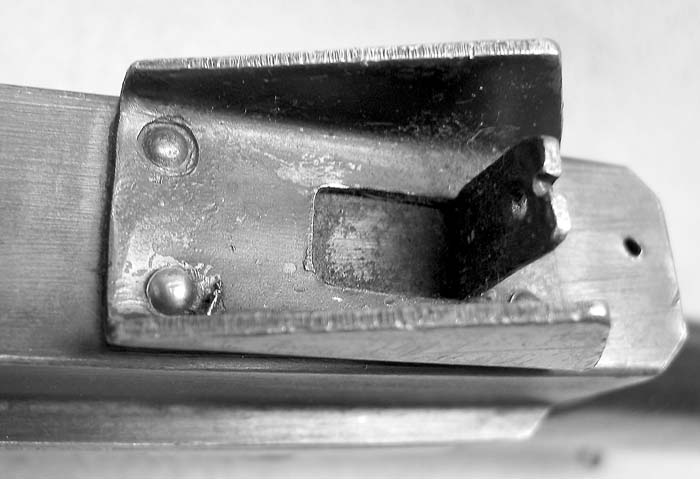
Although similar in design, the contours of the disconnector are very different from a U.S.-made example. The M1-style magazine catch is crudely made compared to the other parts, a characteristic that all of the Turkish Thompsons seem to share. It’s attachment by a washer and cotter pin on the right side of the receiver is also common to all of the Turkish Thompsons observed.
Each of the magazine catches has its own unique method and pattern of checkering on the pad portion, obviously hand-made like the rest of the part. Most are the M1-style catch, but the early Turkish Thompsons sport a 1921/28-style catch designed originally for use with drum magazines. Standard Thompson drum magazines cannot be used with M1 or M1A1 Thompsons, so this style catch is likely a result of the Turkish Cypriots simply copying a U.S.-made part without knowing the reason for the different profile.
Though small in number like their Chinese-made counterparts, the Turkish Thompsons still represent an important part of the military history and lore of the Thompson submachine gun. Anyone with information on the Turkish Thompsons is asked to contact the author through Small Arms Review.
(The author would like to thank the following people for their invaluable assistance in the research for this article: Major J.M.G. Gagné, Canadian Airborne, Retired; Ainsley Christensen, Collections Manager, Canadian Airborne Forces Museum; Gary Dare, RCMP, Ottawa, Canada; John Cross in the U.K.; and, Richard Jones, SLA Resource Manager, National Firearms Centre, U.K.)
| This article first appeared in Small Arms Review V12N3 (December 2008) |










